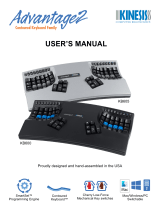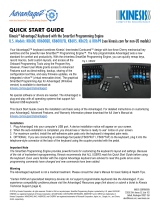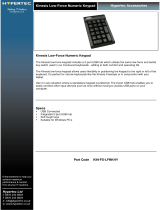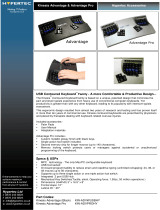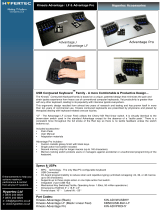Page is loading ...

1
SmartSet App User Manual - Version 1.2.3 for Windows & Mac
Overview
The SmartSet App lets you design and edit custom
layouts, build powerful macros, and customize keyboard
settings. The App works in conjunction with onboard
programming, but it has several additional tools for
power users. There are Windows and Mac versions of
the App and all custom settings are saved directly to the
keyboard, for use on all Operating Systems.
Note: Unlike conventional keyboard software that uses
custom drivers, the SmartSet App is driverless and does
not update the keyboard settings dynamically. Changes
are implemented upon disconnecting the v-Drive.
A Windows version of the SmartSet App is pre-loaded onto all newer (4MB) Advantage2 keyboards for your
convenience. That version of the App is designed to be run directly from the v-Drive (do not transfer it to your PC).
Mac users, owners of older 2MB Advantage2 keyboards, or those who wish to run the latest version of the App will need
to follow the instructions below to download the latest version of the App from our website.
Launching the App
First use the onboard shortcut to enable Power User Mode (Program + Shift + Esc) and then use the onboard shortcut to
connect the v-Drive (Program + F1). When you connect the v-Drive, your PC will now recognize the keyboard as a
“Removable Storage Device” and a pop-up may appear.
Locate the “KINESIS KB” drive in your file manager and then double-click the
Windows version of the App to launch it. Note: The App can sometimes take 10-
15 seconds to launch while it reads the configuration settings so only double-
click it once. If the App is not present on the v-Drive, follow the instructions
below to download it from our website.
Downloading the Mac Version or a newer Windows version
Periodically Kinesis will release SmartSet App updates with new features or fixes (click the “Question Mark” icon in the
top right corner of the App to see the version number). The latest versions of the SmartSet App for both Mac and
Windows can be downloaded from our website. Windows App version 1.2.3 (or later) can be transferred to v-Drive or run
from your PC in “Desktop” mode (with the v-Drive connected). The new 64 bit Mac App version 1.2.3 is too large to fit on
the v-Drive and must be run from your Mac in Desktop mode (with the v-Drive connected).
Download new Apps here: www.kinesis.com/support/advantage2/#SmartSet-app
Active Layout
When you run the SmartSet App, it will automatically load a graphical representation of the currently-active layout. The
graphical layout shows all assigned key actions in both layers (including the optional Advantage Foot Pedal), including
any custom remaps and macros. To view or edit a different layout, use the “Load” button at right and select the desired
layout file (.txt format) from the active subfolder on the v-Drive.
Exact v-Drive contents may vary

2
Remapping Keys
You may “remap” (aka reassign or rebind) any supported key action to any of the keys on the Advantage2, except for the
dedicated “Keypad” and “Program” keys.
Designating the Active Key: Select the physical key you wish to reprogram by clicking the diagram to designate it as
the Active Key. The Active Key will be highlighted to indicate that it is currently designated for remapping and/or macros.
Then type the key you would like to assign to that position on the Advantage2. Remapped keys are displayed with blue
legends.
Navigating Layers: Each key has a top-layer (“Top”) action and a secondary keypad-layer
(“Kp”) action that can be customized separately. Use the layer slide-switch in the App to
move between the layers during programming, the “Keypd” key on the keyboard to change
layers during use. You can also “Shift” the keypad layer on using the default action of an Advantage single or middle
foot pedal. “Keypad Shift” keeps the keypad layer on until the pedal is released.
Special Actions: If you wish to assign a Special Action that isn’t found on the Advantage2 by default, click the “Special
Actions” button and select from the drop-down menus of supported actions. For example, any remappable key can be
programmed to “shift” or “toggle” the keypad layer or perform a mouse button action.
Cancel/Done: Once you have the desired key action, click “Done” to accept that Remap or click “Cancel” to revert back
to the previously stored action. If you navigate away from the active key your last input will be stored as the new key
action. Note: changes will not be implemented until you save the new layout and disconnect the v-Drive.
Reset: If you make a mistake or want to start over, click one of the three Reset buttons (key, layer, layout). Note: If you
accidentally perform a Reset operation, exit the App without saving your changes to revert back to your original layout.
Programming Macros
Trigger Key(s): To program a macro, first click on one of the full-size, non-modifier keys in the layout to act as your
primary trigger key. Once you have selected a valid trigger key, the Macro Programming Region will become active
(shown below). Macros can be triggered solely by the primary key or as a multi-key combination using up to 3 modifier
co-triggers. To designate a modifier “co-trigger” simply click one of the gray buttons.
Macro Content: After selecting the trigger key(s), click inside the macro text box and type your macro content. The App
will record every single keystroke from the keyboard so if you make a mistake, you’ll need to use the “Backspace” or
“Clear” buttons in the App to edit.
Basic alphanumeric characters are displayed in black text whereas “key actions” are displayed as red text inside of curly
brackets as “tokens”. Once you are done programming your macro, click “Done” to assign it to the trigger key(s) or click
“Cancel” to abandon the macro. Note: The timing of keystrokes is not recorded but you can insert delays manually using
the Special Actions menu as described below.
Macro programming box with a key selected

3
Special Actions within macros: With the Special Actions button you can assign a pre-programmed macro (e.g., Cut,
Copy, Web Home), a custom Windows key combination or a mouse click. You can also insert brief delays into a macro
to improve playback performance or timing. Delays are available in 125 and 500 millisecond increments and they can be
sequenced to achieve delays of various durations.
Multiple Macros per Key: If you wish to assign a 2nd or even 3rd macro to the same primary
trigger key (e.g., Right Ctrl+Capslock, Right Shift+Capslock, and Right Alt+Capslock), you will
need to assign a modifier key as a co-trigger. Simply re-select that primary trigger key and then
click the “#2” or “#3” radio buttons to get access a fresh macro text box. Then select a unique trigger key combination
using one of the six standard modifiers as a co-trigger.
Note: The “Windows” key is not recommended as a co-trigger, as it can cause unpredictable playback or can require
experimenting with delays and speed to get it to play as desired.
Copy & Paste: You can copy your favorite macros from one trigger key to another, or even between different layouts.
Individual Playback Speed: By default, all macros will playback at the keyboard’s “Global Speed” setting. The Global
Speed setting can be adjusted using the onboard shortcut or using the “Global Macro Speed” slider under Settings
(discussed below). However, to achieve optimal playback performance for each macro we
recommend using the individual macro “Playback Speed” slider in the App to assign a custom
playback speed specifically tailored to each macro and its intended playback environment, and not
rely on the Global Speed setting.
Customizing Keyboard Settings
On newer 4MB models of the Advantage2 the global Keyboard Settings are editable from the
SmartSet App. Older 2MB models must be customized via “onboard shortcuts” or “direct editing”.
Global Macro Speed: Control the playback speed for all macros that don’t have an “Individual
Playback Speed” assigned to them. Slide it to “9” for 3,000 WPM, down to “1” for 50 WPM, or “0” to
temporarily disable all macros without deleting them from any layout.
Status Report Speed: The Status Report is a convenient utility that prints-to-the-screen the most
important keyboard settings using the onboard shortcut Program + Esc. Make sure you have a text
editing program open and selected (“in focus”) before you try to run a Status Report!
The default Status Report playback speed is “3”, but some computers may require a slower speed
for proper playback. Slide it to “0” to deactivate the Status Report.
Key Clicks: Enable/Disable the standard electronic “click” for each key.
Key Tones: Enable/Disable the electronic warning “tone” for Caps Lock and the Keypad Key.
Auto v-Drive: The v-Drive will always be open but multimedia and mouse actions will be disabled.
*Playback speeds are approximate. Exact speeds will depend on the length of the macro, your computer, and the application.
Seng Speed1 Speed2 Speed3 Speed4 Speed5 Speed6 Speed7 Speed8 Speed9
AconsPerSecond 4 8 12 22 35(default) 62 85 125 250
WordsPerMinute 48 96 144 264 420 744 1,020 1,500 3,000

4
Saving and Implementing Changes
Load: Use the Load button to load any existing layout file from the v-Drive to the App for
customization. Note: The layout is not loaded as the “active” layout to the keyboard.
New: To create a new “hotkey” layout, click New and select from a QWERTY or Dvorak base and
then chose which key to assign as the “hotkey”. Note: This layout will need to be loaded to the
keyboard separately for use.
Save: Before exiting the App it is necessary to Save your changes and then “eject” the drive in your
operating system by right clicking the KINESIS KB .
Implementing Changes: The keyboard is not dynamically updated by the App and saving your changes via the App
alone is not sufficient to implement them to the keyboard. Changes are implemented when the v-Drive is disconnected.
Note: If you were editing a layout other than the active layout, you will need to designate that layout as the new active
layout separately using the appropriate onboard shortcut for the base QWERTY or Dvorak layout, or the designated
hotkey layout shortcut.
Support, Troubleshooting Tips, & FAQs
Below are tips for accessing and operating the Advantage2 SmartSet App:
Visit www.Kinesis.com/Support/Advantage2 for Troubleshooting Tips, FAQs, instructional
videos, user manuals, or to download the latest version of the SmartSet App.
System Requirements: Windows 7+ or macOS 10.6+. Minimum display resolution of 1152x864. Note: App may not
display properly on ultra high-definition monitors.
For best results, keep the v-Drive closed when not using the SmartSet App and refrain from using onboard shortcuts
while the v-Drive is open. Multimedia and mouse actions are disabled while the v-Drive is open.
Do not delete or modify the folders on the v-Drive. Doing so could compromise the ability of the SmartSet App to
identify and save layouts and keyboard settings.
v-Drive Troubleshooting: The SmartSet App reads and writes to the “simple text” files on the v-Drive, so if they are
moved, damaged, renamed or otherwise modified, it can cause the App to malfunction. Disconnecting the v-Drive
from your PC while folders/files on the v-Drive are in use can cause files to be corrupted so always use “eject” before
closing the drive if any files have been edited (right-click the KINESIS KB drive and select Eject).
If the App fails to launch, try re-plugging the keyboard, performing a Hard Reset (backup any custom layout files
first), or downloading a fresh copy of the App.
If you need technical assistance, please visit www.kinesis.com/support/contact-a-technician/ to submit a Trouble
Ticket and a trained technician will respond to you as soon as possible
.
In-App Help Menu
Version: April 8, 2020
/
